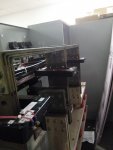winnie
Senior Member
- Location
- Springfield, MA, USA
- Occupation
- Electric motor research
If you short the output right at the source, then you won't have significant voltage to measure at the source. But if you connect your bus bar assemblies to the source, and short at the _far_ end of the bus bar assembly, then at the _source_ side of the bus bar you should be able to measure voltage.
Gar's calculations are an estimate of what the voltage will be, with variations for different connections.
-Jon
Gar's calculations are an estimate of what the voltage will be, with variations for different connections.
-Jon


